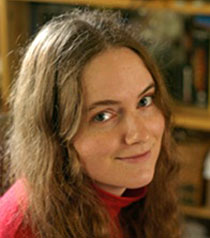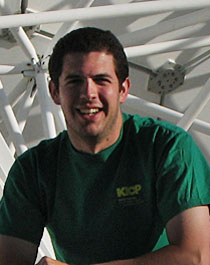 |
 |
 |
 |
 |
 |
 |
 |
 |
 |
 |
 |
|
Talks & Events
|
Ph.D. Thesis Defenses: 2011
Rayleigh-Taylor Unstable Flames: the Competition between Burning, Gravity and Self-Generated Flow A comprehensive study of the cool gas content of massive dark matter halos Ph.D. Committee: Michael Gladders, Andrey Kravtsov, Joshua Frieman. "Jean-Rene's PhD thesis has provided new insights into the growth of massive galaxies, discovering the unexpected presence of extended reservoir of cold gas. In the fall, he will be starting a new position at Caltech as a Millikan fellow." - Hsiao-Wen Chen, PhD advisor. Thesis Abstract: Characterizing the structure and evolution of the cool gas in dark matter halos is a key element in current models of galaxy formation. Several physical mechanisms have been introduced to explain the origin of the cool, T ∼ 1e4 K gas in the dark matter halos of normal galaxies. Some of these mechanisms include cold accretion from the IGM, gas-rich galaxy mergers, starburst driven outflows, and thermal instabilities generated within the hot coronal gas. Unfortunately, direct empirical data are lacking and these mechanisms remain poorly constrained. My thesis focuses on the empirical determination of the cool gas content of massive dark matter and directly addresses the physical origin of the gas. Specifically, I will present a series of empirical constraints on the cool gas content of dark matter halos hosting Luminous Red Galaxies (LRGs) at z ≈ 0.5. In my talk, I will describe the outcome of a clustering analysis done on a population of MgII absorption doublets and its implications for the presence of cool gas in massive halos. I will then describe the main results of an on-going spectroscopic survey of LRGs and present measurements of the covering fraction of cool gas in these galaxies. I will also present the results of a stellar population synthesis analysis done on a sample of spectroscopic LRGs. This analysis allows me to directly assess whether or not there is a connection between the presence of the gas and the recent star formation activities of the galaxies. Finally, I will briefly introduce the preliminary results of a kinematical study of the MgII absorbers to explore the physical origin of the gas in more details. Broadband Photometry of 105 Giant Arcs: Redshift Distribution Constraints and Implications for Giant Arc Statistics Ph.D. Committee: Andrey Kravtsov, Richard Kron, Stephen Kent. "Dr. Bayliss' Ph.D. research has focused on the identification and characterisation of several new large samples of gravitational lenses. In particular, his work with both imaging and spectroscopic data, from a range of telescopes, has established for the first time the redshift distribution of the lensed sources, which is a major milestone in using these lenses as cosmological probes and as environments in which to test our understanding of dark matter halo structure." - Michael Gladders, PhD advisor The phenomenology of maverick dark matter Ph.D. Committee: Jonathan Rosner, Henry Frisch, Ilya Gruzberg. Thesis Abstract: Astrophysical observations from the galactic to the cosmological scales point to a substantial non-baryonic component to the universe's total matter density. Although very little is presently known about the physical properties of dark matter, its existence offers some of the most compelling evidence for physics beyond the standard model. In the weakly interacting massive particle (WIMP) scenario, the dark matter consists of particles that possess weak-scale interactions with the particles of the standard model, offering a compelling theoretical framework that allows us to understand the relic abundance of dark matter as a natural consequence of the thermal history of the early universe. From the perspective of particle physics phenomenology, the WIMP scenario is appealing for two additional reasons. First, many theories of physics beyond the standard model contain attractive WIMP candidates. Second, the enhanced interactions between WIMPs and standard model particles imply the possibility of detecting scatterings between WIMPs and detector nuclei in direct detection experiments, products of WIMP annihilations at locations throughout the galaxy, and WIMP production signals at high-energy particle colliders. In this work, we use an effective field theory approach to study model-independent dark matter phenomenology in direct detection and collider experiments. The maverick dark matter scenario is defined by an effective field theory in which the WIMP is the only new particle within the energy range accessible to the Large Hadron Collider (LHC). Although certain assumptions are necessary to keep the problem tractable, we describe our WIMP candidate model-independently by specifying only its spin and dominant interaction form with standard model particles. Constraints are placed on the masses and coupling constants of the maverick WIMPs using the Wilkinson Microwave Anisotropy Probe (WMAP) relic density measurement and direct detection exclusion data from both spin-independent (CDMSII and XENON100) and spin-dependent (COUPP) experiments. We further study the distinguishability of maverick WIMP production signals at the Tevatron and the LHC---at its early and nominal configurations---using standard simulation packages, place constraints on maverick WIMP properties using existing collider data, and determine projected mass reaches in future data from both colliders. We find ourselves in a unique era of theoretically motivated high-precision dark matter searches with the potential to give us important insights, not only into the nature of dark matter, but also into the physics that lies beyond the standard model. Radio Sources in Galaxy Clusters Ph.D. Committee: John Carlstrom, Dan Hooper, and Don York. "Dr. Gralla's thesis work has focused on the redshift evolution of the radio source population in galaxy clusters, over a broad swath of both redshift and cluster mass. Understanding the evolution of this active galaxy population is important for models of heating by AGN of the intra-cluster medium, as well as providing input to models addressing the impact of radio sources on Sunyaev-Zeldovich surveys for galaxy clusters." - Michael Gladders, PhD advisor. Thesis Abstract: I present a statistical analysis of the radio source population in galaxy clusters by matching radio sources from two large-area surveys with optically-selected galaxy clusters spanning a wide range of redshift ($sim0.3$ to $sim$ 1) from the Red-Sequence Cluster Surveys (RCS). The first RCS (RCS1) is well-characterized within a cosmological context, with richness measurements calibrated over a wide redshift range. I have focused on the redshift evolution of the radio source population. The richest clusters in the sample have more radio sources than clusters with low or intermediate richness. When divided into bins according to cluster richness, there is no significant difference ($> 1.5sigma$) in the number of radio sources per unit of cluster mass for the galaxy clusters with $0.35 < z < 0.65$ as compared to the galaxy clusters with $0.65 < z < 0.95$. Thus the entire RCS1 sample can be characterized by the number of (L$_{1.4 GHz} > 4.1 imes 10^{24}$ W Hz$^{-1}$) radio sources per unit (10$^{14}$ M$_{odot}$) mass, which is measured to be 0.031$pm$0.004. I further characterize the population of galaxy cluster-related radio sources through visual inspection of the RCS1 images, finding that although the radio activity of brightest cluster galaxies (BCGs) also does not strongly evolve between the high and low redshift samples, the lower-redshift, richest clusters are more likely to host radio-loud BCGs than the higher-redshift, richest clusters or poorer clusters at the 2-$sigma$ level. The second RCS (RCS2) contains a much larger galaxy cluster sample selected from $>500$ square degrees of imaging data. I have refined and applied an automatic algorithm to identify the BCGs in clusters, and I find some 3$sigma$ evidence that the low redshift clusters have a higher fraction of radio-loud BCGs than the high redshift clusters, further supporting the initial evidence from RCS1. I also investigate the prevalence of extended sources in clusters and the radio activity in non-BCG red sequence galaxies, for which I find no evidence for evolution, in spite of the strong evolution that has been seen in the cluster X-ray AGN population. Investigation of Molecular Cloud Structure around Infrared Bubbles: CARMA Observations of N14, N22, and N74 Ph.D. Committee: Roger Hildebrand, Stephan Meyer, Wayne Hu. "An important unresolved problem in studies of star formation is the role of feedback. How does the formation of stars in a dense molecular cloud affect the evolution of the cloud and the formation of successive generations of stars? Reid's research uses newly developed instrumental capabilities of the CARMA telescope array to explore the structure and motions in molecular clouds around "bubbles", pockets of hot ionized gas created by ultraviolet radiation from massive young stars. CARMA's high angular resolution and ability to observe many different parts of the millimeter-wavelength spectrum at the same time allow it to efficiently probe star-forming clouds at scales comparable to the size and density of the "molecular cores" required for the formation of additional high-mass stars." - Doyal Harper, PhD advisor. Thesis Abstract: We present CARMA observations in 3.3 mm continuum and several molecular lines of the surroundings of N14, N22, and N74, three infrared bubbles from the GLIMPSE catalog. We have discovered 21 compact continuum sources and confirmed their associations with the bubbles using velocity information from HCO+ and HCN. We have also mapped fragments of quiescent clouds in the vicinity of the bubbles using N2H+. By combining our data with public survey data, we establish about half of our continuum sources as star-forming cores. We also use survey data with the velocity information from our molecular line observations to describe the morphology of the bubbles and the nature of the fragmentation. We conclude from the properties of the continuum sources that N74 lies at a much greater distance than previously assumed. We also present tentative evidence of molecular clouds being more fragmented on bubble rims compared to dark clouds, suggesting that triggered star formation may occur, though our findings do not conform to a classic collect-and-collapse model. |






